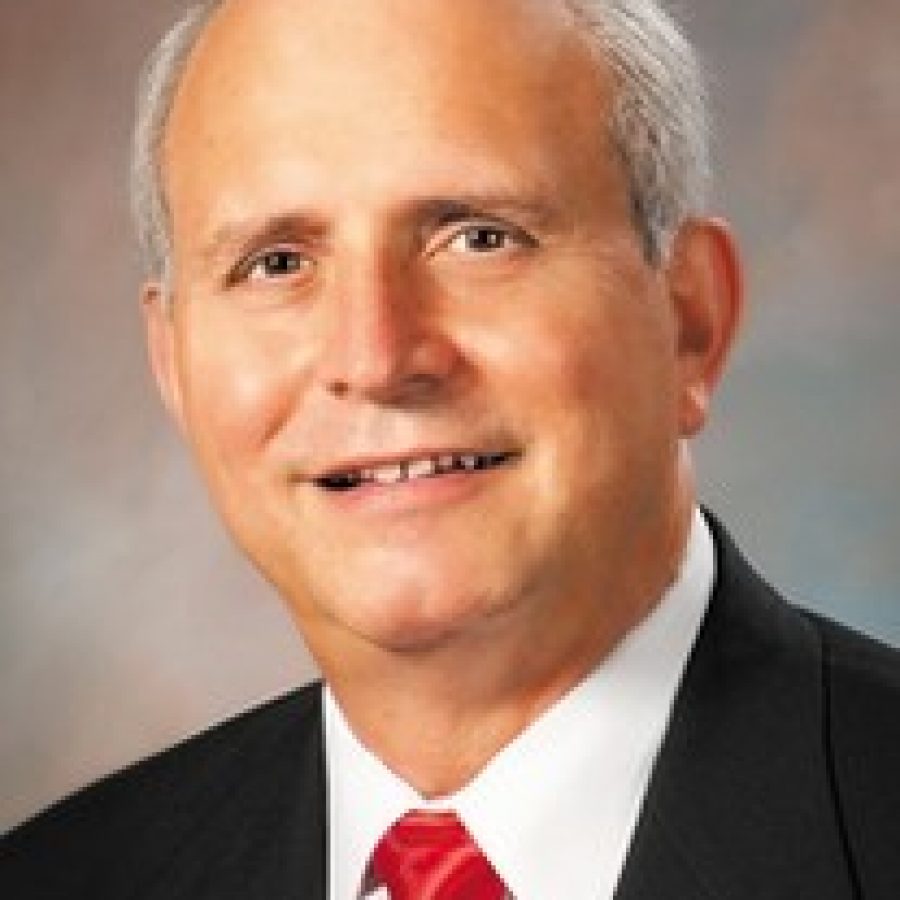The buildings that comprise Lindbergh High School are reaching the end of their lifespan, according to Lindbergh Schools Superintendent Jim Simpson.
Because the high school structures are nearing the end of their useful life, district officials and the Board of Education in the not-so-distant future will have to make a choice of whether to make piecemeal repairs or replace the entire facility, Simpson told the Call.
“LHS has reached the end of its lifespan in so many ways, in terms of facilities,” he said, adding that he and Executive Director of Planning and Development Karl Guyer “talk frequently about sooner or later we’re going to have to start putting millions of dollars into aging infrastructure. We’ve got canopies that we’re just barely holding up.
“Canopies are extremely expensive. You’ve got codes when you put up canopies, and these codes say it’s got to be super substantial. It cannot cave no matter what,” Simpson said.
Canopy replacement alone at Lindbergh High could easily cost $500,000 or more, he estimated.
Most of the buildings on the 65.5-acre Lindbergh High campus date back to the 1950s. Over time, additional buildings have been constructed, such as the auditorium in 1985, along with periodic improvements such as renovated locker rooms, a natatorium with a swimming pool and a multipurpose room in 2003.
More recently, Gym 3 was renovated, as the gym’s original 1967 wood floor and bleachers were replaced as part of the Proposition G bond issue, which was approved by voters in April 2014. In early 2016, the school’s cafeteria was expanded to provide much-needed additional seating for students, who in recent years have been crowded out of the main cafeteria, sitting at tables in hallways and commons areas and even on the floor. The cafeteria addition seats roughly 430 students.
Other recent improvements include two additional science classrooms, additional seating in the football stadium and stadium restroom completion.
Construction currently is underway on a new two-story, 24,000-square-foot administration building at the 2.2-acre former Johnny’s Market site, 11555 Gravois Road.
The district’s Central Office currently is housed at Lindbergh High, occupying roughly 20,000 square feet with 12 departments and roughly 50 employees.
Construction of the new Central Office building will be completed this fall, and the move eventually will restore eight to 10 classrooms at the high school to address the surging enrollment the district is facing.
The majority of buildings on the high school campus are facing a variety of infrastructure issues, such as aging stairways. In fact, one set of stairs has been closed for “major repairs,” Simpson said.
“Our stairs in some parts of the high school have actually reached the end of their lifespan,” he said. “You say, ‘Well, what does a stair look like at the end of the lifespan?’ And the answer is, stairs are metal structures with an inch of concrete poured in the treads. So you look at them, you don’t see metal because it’s all covered up. But it’s in there and so when they reach the end of their lifespan, you step on the concrete and all of a sudden, your foot goes through because that metal, like all metal, has just gotten thin …”
Repairs to the stairwells cost “big money,” Simpson said. “We’ve got a lot of that stuff at the high school, and so we’re going to come to a fork in the road: Are we going to put millions of dollars into LHS and Band-Aid it up or are we going to do what we know we have to do somewhere down the road, and that is replace LHS the same way that other communities replace their high schools that have reached the end of their facility life.
“Lindbergh will have no choice but to do that at some point. Now the question is, what point? Now my litmus test is the same one that all people who own homes and cars, when your car starts breaking down all the time, you’re at your fork in the road. Are you going to keep putting heavy dollars in this old car, or are you going to get yourself a much-newer car that will run without taking it into the shop all the time?
“Well, buildings do the same thing. In the years that come, there will be millions of dollars that will have to be placed in LHS and then you have to worry — and this is a big one — you don’t want to put brand-new things in and then five years later, tear them down. So you’ve really got to get that part of the equation right. You’ve got to be careful that you don’t take scarce resources making something new and then rip it out in a few years …”
The Board of Education will face many challenges in meeting the district’s many needs, according to Simpson.
“… There’s only so much the community can support with higher taxes, so you can’t meet all those needs,” the superintendent said. “So you have to prioritize those needs. This board will have to prioritize those needs and decide what they’re going to do. LHS is certainly reaching that point of heavy repairs.”
Any renovations or new construction also will have to address the issue of campus security, as the existing campus “is the most unsecure high school probably that you could have. With the California-style openness we have — we count them — 52 doors open every hour, and there’s no way around that because kids have to get from building to building … You can’t get 2,100 students in four minutes around that campus without having 52 doors open. There’s no way. You say, ‘Don’t open them.’ Well, it wouldn’t work. There’s no way for it to work.
“Some of those buildings are just not connected to anything. They stand alone. The world we live in today, you need a secure campus in which it’s designed totally to be self-contained so that you can make sure that nobody can get in any door without total security. That’s an LHS significant upgrade. That would be a very big upgrade for us and you can get a lot of modern effectiveness out of your educational campus. There’s so much we know now that we didn’t know in 1960.”
The superintendent cited the district’s new elementary school, Dressel, which will open this August, as an example of a modern school with a secure campus.
“When we do the tours of Dressel, people will see a 2017 modern school building, and they will be amazed because they’re used to seeing 1960 buildings. They will be amazed,” Simpson said. “You will be amazed at what a 2017 state-of-the art elementary looks like because in our brains we’re used to 1960 …”








